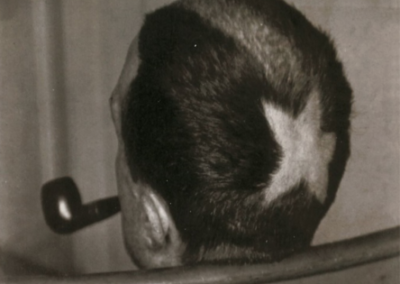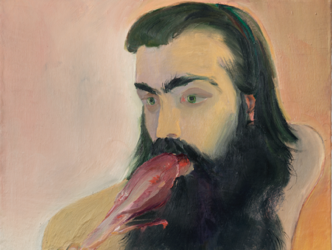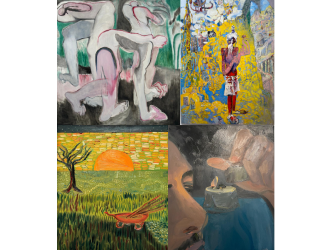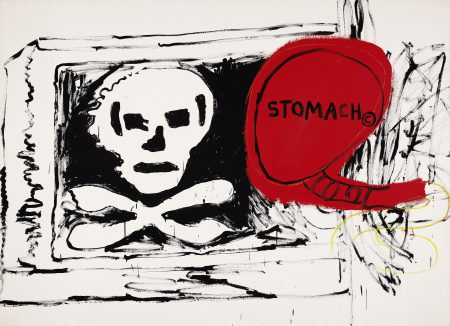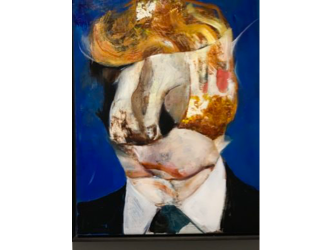His slow manner of speaking is characterized by a strong Belgian accent and his physique has remained the same all the time I have known him.
He is Sylvio Perlstein, a true character, an atypical collector who is rather wild by nature, whom I met during the 2000s before managing to coax an interview out of him in 2004.
He is allergic to any kind of revelation or obligation. It is impossible to reach him on his mobile phone. He occasionally answers the landline at his home in the Paris region designed by a famous architect, unless he is in Anvers where he works as a diamond merchant.
I attempted to meet with him before he left for New York on the occasion of an exhibition of his collection organized by the Hauser & Wirth gallery from 26 April.
The space across three floors of the 22nd Street gallery will be filled with 360 artworks by 250 artists.
He says: “I took a one-way ticket. I don’t really know when I’ll be coming back. As for the collection, I’ve forgotten everything, I can assure you I don’t remember anything at all. I have nothing to say.” All the same, we did exchange a few words, particularly as an article sprinkled with a few memories has just appeared on this exhibition in the New York Times. I ask him what he is going to sell. “Absolutely nothing! In the past David Zwirner suggested that I exhibit the collection. But at the last minute I received a prices list. I refused, and everything was cancelled. But I still have a lot of respect for David Zwirner.”
At Hauser & Wirth, scientific advisor Matthieu Humery confirms that nothing is for sale: “The galleries like valuable collections like this and Hauser & Wirth were charmed by the collector himself and by his collection which is unique and never shown in the United States. Sylvio is 87 years old. He wanted to display it in New York.”
This is what I wrote in 2004, which strikes me as being equally valid today:
“Hey, did you know that art doesn’t exist?” The long banner denying the existence of art is placed in the middle of Sylvio Perlstein’s living room. The man, a diamond merchant from Antwerp, doesn’t seem to be jokey by nature. But you can’t always trust appearances. In his large, luxurious suburban house, several of the artworks clearly display a penchant for mockery and wit.
Without further comment, he introduces the multitude of contemporary sculptures and paintings carefully arranged around him, simply by giving the artist’s name.
The banner was made by the French artist Ben, for a Fluxus exhibition in the United States.
He has been making regular trips to New York since the 1950s when he was about 20 years old. And strangely, this man who knew nothing about art, either avant-garde or classical, instantly got involved in the contemporary art scene. In fact, his collection seems mainly to have emerged from his affinities with a group of young men there who would all go out together.
In those days, the epicenter of artistic life in the Big Apple wasn’t a gallery or a museum. It was a bar, in the area that would later be known as Soho.
In the evenings, everyone would meet up at Max’s Kansas City. “You know, it was the hippy era. The music was loud. People drank a lot. One of the very first people I met was Sol Lewitt”. He explains that “the minimal artists were not yet recognized or sold in the United States. They were mainly showing in a few galleries in Germany and in Belgium. So whenever they met someone from these countries they always gave them an especially warm welcome”.
Sol Lewitt took him into his studio and showed him his work. Perlstein bought several of them, including drawings composed of infinite, almost imperceptible lines. While Sylvio Perlstein may be fortunate, he also doubtless has a good eye. As a result of these successive “minimal meetings”, today the diamond dealer’s home features artworks the likes of which are rarely seen outside museums in Europe. They were all bought very early on, like Dan Flavin’s Neons. At the collector’s home, one is placed in a corner, between two walls.
This is also the case for a gigantic white-felt work by Robert Morris based on a series of folds, like a plain-metal module made by Donald Judd.
“I know what you’re thinking: you’re wondering how much all this is worth,” remarks the collector.
“But I just like them, that’s all”. Sylvio Perlstein also hates being asked why he likes an artwork. Yet the questions seem legitimate given the presence, in his very smart 1930s-style living room, of a real wooden cart filled with straw, in which a long, thin neon work has been placed. The installation was made by one of the big names in Italian art, Mario Merz, one of the leaders of the Arte Povera movement.
In truth, Sylvio Perlstein’s work as a collector is instinctive yet pugnacious.
After his initial encounters, he continued making new discoveries. He visited New York galleries such as Leo Castelli’s and bought several works by Bruce Nauman.
In Belgium, Sylvio Perlstein became acquainted with Marcel Broodthaers. As a testament to this friendship, there are monochrome paintings covered in empty moulds in the kitchen, and a row of eggshells placed under a bell, both of which are works by the Belgian artist who died prematurely in 1976.
Later, Sylvio Perlstein became a friend of Keith Haring’s and also bought works by Basquiat. He wonders: “What will be remembered of the 1980s other than Keith Haring and Jean Michel Basquiat?”
His collection of minimal art is now largely a memory. He doesn’t buy anymore. That leaves Surrealist photography, which he discovered in the 1970s thanks to Man Ray – another important encounter – and which he has never stopped collecting since. But his conclusion on collecting today is that “Money has become an inherent part of the system.”
For those who understand Portuguese here is a little interview conducted during the exhibition of his collection at the MAM in Rio in 2014. (He also shown his collection in 2006 in Paris at La Maison Rouge):
26 april-27 july. www.hauserwirth.com. New York
Support independent news on art.
Your contribution : Make a monthly commitment to support JB Reports or a one off contribution as and when you feel like it. Choose the option that suits you best.
Need to cancel a recurring donation? Please go here.
The donation is considered to be a subscription for a fee set by the donor and for a duration also set by the donor.

